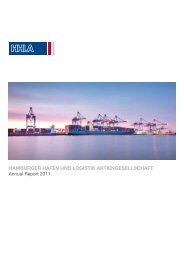travel guIde - Hhla
travel guIde - Hhla
travel guIde - Hhla
Create successful ePaper yourself
Turn your PDF publications into a flip-book with our unique Google optimized e-Paper software.
<strong>travel</strong> <strong>guIde</strong><br />
A journey through the world of hAMBurger hAfen und logIStIK<br />
AKtIengeSellSchAft<br />
ShoeS in tranSit<br />
the global journey of a container full of shoes from china to Austria.<br />
Coal bulkerS and ore trainS<br />
hansaport supplies raw materials to the power stations and steelworks of northern germany.<br />
high-teCh Climate proteCtion<br />
hhlA container terminal Altenwerder reduces its co 2 emissions.
Your <strong>travel</strong> guide<br />
dear Sir or Madam<br />
welcome to our <strong>travel</strong> guide! we look<br />
forward to taking you on an exciting<br />
and inspiring journey – through our<br />
company and into the world of logistics.<br />
As one of europe's leading<br />
companies in the maritime logistics<br />
sector we are a driving force behind<br />
global trade. the powerful resurgence<br />
of the export trade in Asia and South<br />
America as well as in many of the economies<br />
of central and eastern europe<br />
prompted a strong recovery in handling<br />
and transport demand at the Port of<br />
hamburg. And this, in turn, has led to<br />
strong demand for our services along<br />
the entire transport chain.<br />
with new megaship berths and<br />
the high-tech container rail terminals,<br />
our company is well equipped to support<br />
the continuing growth in world<br />
trade. the systematic expansion of<br />
our transport network for the european<br />
hinterland is already leading the way<br />
into the future of goods transportation:<br />
from road to rail – eco-friendly and economical.<br />
Intelligent processes are an essential<br />
element in this development.<br />
they push forward every aspect of<br />
what we call the “industrialisation of the<br />
transport chain” from the ports to the<br />
hinterland. we combine seaport and inland<br />
terminals that incorporate cutting<br />
edge technologies with pioneering new<br />
rail transport systems. with a seamless<br />
network for transporting goods for the<br />
“last mile” to and from the inland terminals,<br />
we are ultimately building an integrated<br />
cargo transportation system.<br />
every interface, route and operator is<br />
optimally linked into the process chains<br />
and information can therefore flow freely<br />
throughout the entire network.<br />
Accompany a container packed<br />
with shoes on its 21,000-km journey<br />
from the manufacturer in the chinese<br />
city of wenzhou to a shoe store in<br />
Vienna's city centre. join us on a journey<br />
into tomorrow's world and discover<br />
how innovative concepts and technological<br />
progress are leading the way<br />
to greater efficiency, sustainability and<br />
climate protection and helping to define<br />
the future of the logistics sector.<br />
hhlA has a history stretching<br />
back 125 years. As a company we are<br />
always on the move, energising the<br />
flows of global trade in europe both today<br />
and in the future. we never forget<br />
that goods are <strong>travel</strong>lers, too, and deserve<br />
our full attention. I wish you bon<br />
voyage – we look forward to seeing you<br />
again in the Port of hamburg.<br />
Klaus-dieter Peters<br />
chairman of the executive Board<br />
hamburger hafen und logistik Ag<br />
hhla <strong>travel</strong> guide 3
ContentS<br />
3 Your <strong>travel</strong> guide<br />
6 the logiStiCS hub<br />
the Port of hamburg is the beating heart of hhlA. A map shows how and<br />
where the company manages global flows of goods.<br />
8 well ConneCted<br />
An efficient network of steel rails and trains connects german seaports<br />
with central and eastern europe, reducing the burden of goods traffic on<br />
the roads.<br />
10 ShoeS in tranSit<br />
how the new collection of shoe retailer deichmann <strong>travel</strong>s from china to<br />
Vienna – the diary of a voyage around the world.<br />
18 a ConStant Stream of ContainerS<br />
the hub system or the industrialisation of the transport chain – a journey<br />
into the not-so-distant future.<br />
20 Coal bulkerS and ore trainS<br />
how are vast quantities of coal and ore, destined for the power stations<br />
and steelworks of northern germany, transferred from ship to train?<br />
22 high-teCh Climate proteCtion<br />
electrification, new technologies and electricity from renewable resources<br />
reduce the carbon footprint of the hhlA container terminal Alterwerder.<br />
24 planning and programming<br />
controlling software for port logistics ensures that the packaging units of<br />
globalised trade are handled with maximum efficiency.<br />
26 old briCkS, new reSidentS<br />
how hhlA is transforming the old warehouses of hamburg's historic<br />
Speicherstadt district into desirable workplaces for designers, artists and<br />
media companies.<br />
28 innovationS of YeSterdaY and todaY<br />
hhlA has been a pioneer in the development of modern port technologies<br />
for 125 years and a model for terminal operators worldwide.<br />
30 <strong>travel</strong> phraSe book<br />
31 imprint<br />
4 hhla <strong>travel</strong> guide<br />
hhla <strong>travel</strong> guide 5
trAVel centre<br />
the logiStiCS hub<br />
The Port of Hamburg is a converging point for flows of goods from every corner of the world. Facilities operated<br />
by HHLA are distributed throughout the port area offering its customers a broad range of logistics services.<br />
Finkenwerder Straße<br />
Othmarschen<br />
NORTH SEA<br />
Quelle: hamburg Port Authority<br />
ELBE<br />
WALTERSHOFER HAFEN<br />
Waltersh o f<br />
Straße<br />
Waltershofer<br />
7<br />
Ottensen<br />
Elbchaussee<br />
BURCHARDKAI<br />
Finken<br />
Waltershofer Damm<br />
Kaistraße<br />
Altenwerder Hauptdeich Am Ballinkai<br />
KÖHLBRAND<br />
SANDAUHAFEN<br />
Damm<br />
Altenwerder<br />
Palmaille<br />
Große Elbstr.<br />
Köhlbranddeich<br />
CUSTOMS<br />
RETHE<br />
Luise-<br />
VORHAFEN<br />
Schroeder-<br />
CUSTOMS Nippoldstraße<br />
werder<br />
Altenwerder Hauptstraße<br />
Straße<br />
ALTONA<br />
RAILWAY STATION<br />
FISCHMARKT<br />
HANSAPORT<br />
KÖHLBRAND<br />
BRIDGE<br />
Altona<br />
FISCH-<br />
AUKTIONS-<br />
HALLE<br />
CRUISE<br />
CENTER II<br />
TOLLERORT<br />
Str.<br />
St. Pau l i<br />
St. Pauli Hafenstr.<br />
Steinw erder<br />
KAISER-WILHELM-HAFEN<br />
ROSSHAFEN<br />
Roßweg<br />
SCHUPPEN<br />
71 70<br />
Köhlbrandbrücke<br />
ELLERHOLZHAFEN<br />
SCHUPPEN<br />
84<br />
Simon von Utrecht Str.<br />
REEPERBAHN<br />
ST. PAULI<br />
LANDUNGSBRÜCKEN<br />
82<br />
OLD ELBE<br />
TUNNEL<br />
Breslauer Str.<br />
Neustadt<br />
Alts tadt<br />
G r a s b r ook<br />
Container handling<br />
75<br />
Bulk cargo handling<br />
Altenwerder<br />
ALTENWERDER<br />
RETHE<br />
BRIDGE<br />
4<br />
Fruit logistics<br />
Real Estate<br />
Wilhelm sburg<br />
Vehicle logistics (RoRo)<br />
Port area<br />
RETHE<br />
69<br />
72<br />
CUSTOMS<br />
SCHUPPEN<br />
74<br />
77<br />
SCHUPPEN<br />
81<br />
Buda pester Straße<br />
Hohe S chaar<br />
73<br />
Buchheisterstraße<br />
Damm<br />
Neuhöfer<br />
Reiherdamm<br />
SCHUPPEN<br />
80<br />
NORDERELBE<br />
REIHERSTIEG<br />
Roßdamm<br />
CUSTOMS<br />
Ellerholzdamm<br />
Hohe-Schaar-Straße<br />
Holstenwall<br />
REIHERSTIEG<br />
ST. MICHAEL’S<br />
CHURCH (MICHEL)<br />
Vorsetzen<br />
SPORTHAFEN<br />
Reiherstieg-<br />
Hauptdeich<br />
DOWNTOWN<br />
SCHUPPEN<br />
65<br />
Neuhöfer Straße<br />
HAMBURG<br />
6 hhla <strong>travel</strong> guide<br />
hhla <strong>travel</strong> guide 7<br />
INNER<br />
ALSTER<br />
Willy-Brandt-Straße<br />
Sandtorkai<br />
Lombardbrücke<br />
Bei den Mühren<br />
SPEICHERSTADT<br />
63<br />
SCHUPPEN<br />
64<br />
62<br />
61<br />
60<br />
59<br />
CITY HALL<br />
HAFENCITY<br />
Gr. Grasbrook<br />
Am Sandtorpark<br />
Osakaallee<br />
HANSAHAFEN<br />
Mengestraße<br />
Veddeler Damm<br />
SPREEHAFEN<br />
Brooktorkai<br />
Shanghaiallee<br />
Harburger Chaussee<br />
Überseeallee<br />
CRUISE CENTER I<br />
KEY<br />
SCHUPPEN<br />
52<br />
BEI ST. ANNEN:<br />
HHLA HQ<br />
O’SWALDKAI<br />
53<br />
51<br />
50<br />
48<br />
37<br />
PORT<br />
MUSEUM<br />
Contract logistics<br />
Cruise terminal<br />
CENTRAL STATION<br />
Neuenfelder<br />
SCHUPPEN<br />
29<br />
Straße<br />
Versmannstr.<br />
28<br />
St. Georg<br />
4<br />
Spaldingstraße<br />
Nordkanalstraße<br />
Kloster tor<br />
ÜBERSEE-<br />
ZENTRUM<br />
SCHUPPEN<br />
D<br />
34<br />
SCHUPPEN<br />
F<br />
G<br />
brücke<br />
Dessauer Str. Sachsen-<br />
27<br />
Schumacherwerder<br />
Am Saalehafen<br />
City area<br />
CUSTOMS<br />
CUSTOMS<br />
252<br />
26<br />
25<br />
BALLINSTADT<br />
HHLA facilities<br />
Niedergeorgswerder Deich<br />
Amsinckstraße<br />
ELBE BRIDGES<br />
CUSTOMS<br />
hhla Container Segment<br />
where everything revolves around containers<br />
Shipping lanes and railway lines converge and link up at hhlA container<br />
terminals to form efficient eco-friendly transport chains. the three high per-<br />
formance terminals Altenwerder, Burchardkai and tollerort make the Port of<br />
hamburg one of the most important container hubs in the world. technical<br />
innovations and automated workflows set standards for productivity that are<br />
also an international benchmark. In addition, hhlA is the operator of container<br />
terminal odessa (ukraine), a leading container handling facility in the<br />
rapidly growing region around the Black Sea. Service companies complete<br />
the range of products serving every aspect of the container business.<br />
hhla logiStiCS Segment<br />
know-how for the logistics chain<br />
the logistics segment incorporates a broad spectrum of services: consulting,<br />
special cargo handling and contract logistics. unikai lagerei und Spedition,<br />
for example, is the Port of hamburg's vehicle logistics expert. frucht- und<br />
Kühlzentrum is the german market leader in handling bananas and other fruit<br />
while ulrich Stein gmbh offers essential services for fruit importers. through<br />
hansaport, hhlA has a stake in germany's largest ore and coal terminal.<br />
hhlA logistics stands for high-quality logistics solutions and hPc hamburg<br />
Port consulting, with its subsidiaries uniconsult and hPtI, successfully markets<br />
hhlA's expertise in port technology and project development around<br />
the world.
trAVel routeS<br />
well ConneCted<br />
With the expansion of its inland terminals and the operation of block train connections to the European hinterland,<br />
HHLA organises the flow of goods between the dynamic markets of central and eastern Europe and the coastal<br />
ports. This efficient transportation network is flexible and reduces the burden of truck traffic on the roads.<br />
Antwerp<br />
Brussels<br />
NOR TH SEA<br />
Amsterdam<br />
Rotterdam<br />
Wörth<br />
Bremerhaven<br />
Dortmund<br />
Cologne<br />
Frankfurt/<br />
Main<br />
Kornwestheim<br />
Basle Niederglatt<br />
Frenkendorf<br />
Zurich<br />
SWITZERLAND<br />
Mannheim<br />
Milan<br />
Wolfurt<br />
Bremen<br />
HAMBURG<br />
GERMANY<br />
Ulm Augsburg<br />
Leipzig<br />
Bamberg<br />
Nuremberg<br />
Munich<br />
Venice<br />
Copenhagen<br />
Berlin<br />
Regensburg<br />
Salzburg<br />
Riesa<br />
Pilsen<br />
Enns Vienna<br />
Koper<br />
Malmo<br />
Prague<br />
CZECH REPUBLIC<br />
AUSTRIA<br />
SLOVENIA<br />
Zagreb<br />
Zlin/Iipa<br />
BALTIC SEA<br />
Poznan<br />
Wroclaw<br />
Gdansk<br />
Ostrava<br />
Gliwice<br />
SLOVAKIA<br />
Budapest<br />
Mława<br />
Dunajska Streda<br />
POLAND<br />
HUNGARY<br />
Kaliningrad<br />
Kattowice<br />
8 hhla <strong>travel</strong> guide<br />
hhla <strong>travel</strong> guide 9<br />
Warsaw<br />
Košice<br />
Malaszewicze<br />
LITHUANIA<br />
Sestokai<br />
Vilnius<br />
hhla intermodal Segment<br />
network for europe<br />
minal Minsk network. while Intermodal companies provide highly efficient rail con-<br />
nections between the ports of northern europe and their hinterland, a growing<br />
number BELARUS of inland terminals offer the high quality of maritime logistics to mar-<br />
MOLDOVA<br />
Chisinau<br />
Kiev<br />
Odessa<br />
RUSSIA<br />
hhlA Intermodal operates a comprehensive container transportation and ter-<br />
kets further inland. Metrans, the market leader, connects not only the czech<br />
republic but also Slovakia, hungary and Slovenia with german seaports. Pol-<br />
zug Intermodal puts its focus on Poland and the cIS nations. tfg transfracht<br />
is the market leader in germany and also serves Switzerland and Austria. the<br />
container freight forwarder ctd operates local deliveries close to major german<br />
cities as well as long distance transports to every corner of europe.<br />
keY ctd container-transport-dienst Metrans<br />
tfg transfracht<br />
Polzug<br />
UKRAINE<br />
terminal / depot / office<br />
hhlA Seaport terminal
gloBAl trAVel<br />
ShoeS in<br />
tranSit<br />
More than 21,000 kilometres separate Ningbo on the Chinese coast<br />
and Austria's capital Vienna. This is the story of how Europe's largest<br />
shoe retailer Deichmann sends its latest shoe collection on a voyage by<br />
sea and rail to one of its many stores – and the central roles played by<br />
Hamburg's Container Terminal Burchardkai and the container trains operated<br />
by HHLA subsidiary Metrans. It is the diary of the container CMAU<br />
146090-0.<br />
ningbo, China, 7 november, 11:30 a.m.<br />
the bright blue side of the christophe<br />
colomb, owned by french shipping<br />
company cMA cgM, towers above<br />
the quay at the chinese port of ning-<br />
bo. At nearly 366 metres in length and<br />
with a beam of 51 metres, this giant is<br />
one of the largest container ships in the<br />
world. the last box of goods for europe<br />
has just been loaded – including<br />
container cMAu 146090-0, packed<br />
to the brim with, among other things,<br />
the latest collection of men’s, women’s<br />
and children’s shoes for the deichmann<br />
store at Mariahilferstraße 41 in<br />
Vienna. europe’s largest shoe retailer,<br />
deichmann, manufactures its shoes<br />
all over the world and has a major production<br />
facility in the city of wenzhou,<br />
china. Almost as soon as the deichmann<br />
shoes had rolled off the production<br />
line and been packed, container<br />
cMAu 146090-0 was transported from<br />
wenzhou to ningbo – more than 200<br />
kilometres away – where it was loaded<br />
onto the christophe colomb. container<br />
ships such as the christophe colomb<br />
are crucial to global trade, carrying<br />
heavy loads along fixed routes to tight<br />
schedules. In 2010 cMA cgM and<br />
Maersk set up a new liner service, the<br />
french Asia line 5 (fAl 5/Ae8), linking<br />
Asia’s fast-growing economies with<br />
northern europe. the service is operated<br />
by megaships with a capacity of up<br />
to 14,000 standard containers (teu).<br />
Suez Canal, 28 november, 0:57 a.m. At<br />
a speed of around 7.5 knots, the christophe<br />
colomb forges its way down<br />
egypt’s Suez canal. It is the world’s<br />
most important shipping route and cuts<br />
a huge slice off the long journey from<br />
Asia to europe which would otherwise<br />
involve taking the route around Africa<br />
and the cape of good hope.<br />
hamburg, Container terminal burchardkai,<br />
29 november, 8:00 a.m. on<br />
the monitor in his office at the container<br />
terminal Burchardkai (ctB), hhlA<br />
shipplanner Sven Merzlanovits keeps<br />
a watchful eye on all the containers on<br />
the christophe colomb. they are cleverly<br />
stacked in such a way that they<br />
can be lifted off the ship in le havre,<br />
rotterdam and hamburg without wasting<br />
any time through restacking. the<br />
containers destined for hamburg are<br />
highlighted blue and include container<br />
cMAu 146090-0, which holds some<br />
5,000 pairs of shoes. “of course, ships<br />
with a capacity of over 14,000 standard<br />
boxes pose a particular challenge for<br />
the mighty container ship cMA cgM christophe<br />
colomb – 366 metres long and with<br />
a beam of 51 metres – preparing to dock at<br />
the hhlA container terminal Burchardkai in<br />
hamburg.<br />
the shipping companies and terminal<br />
operators,” explains Merzlanovits.<br />
long before the christophe colomb<br />
reaches hamburg, the qualified industrial<br />
engineer starts working with cMA<br />
cgM on the logistics of discharging<br />
and loading the containers at hhlA’s<br />
terminal. these days, transport chains<br />
are planned in minute detail, carefully<br />
coordinated and finely tuned.<br />
from wenzhou to<br />
hamburg<br />
deichmann – europe’s largest shoe<br />
retailer – manufactures many of its shoes<br />
in the city of wenzhou in china. there,<br />
the shoes are packed in containers and<br />
transported to ningbo by rail – more than<br />
200 kilometres away – where they are<br />
loaded onto a giant container ship and<br />
set sail on their 20,000-km sea voyage to<br />
europe. the Asia to europe service fAl<br />
5/Ae8 operated by the shipping companies<br />
cMA cgM and Maersk completes<br />
the voyage in approx. five weeks.<br />
10 hhla <strong>travel</strong> guide<br />
hhla <strong>travel</strong> guide 11<br />
Hamburg<br />
Rotterdam<br />
Le Havre<br />
Europe<br />
Africa<br />
sea route<br />
railway<br />
Suez Canal<br />
Hamburg<br />
Le Havre<br />
Rotterdam<br />
Asia<br />
Port Kelang<br />
Shanghai<br />
Ningbo<br />
Wenzhou<br />
Yantian<br />
Tanjung Pelepas
le havre, 7 december, 6:00 a.m. fol-<br />
lowing a stop-off at the french port of<br />
le havre, the christophe colomb casts<br />
off from the quay wall and Merzlanovits<br />
starts working out the final details for<br />
the handling process in hamburg. At<br />
the same time, he plans the loading of<br />
the ship at the hanseatic port. his plans<br />
have to take into account stowing instructions<br />
from the shipping company<br />
cMA cgM. the ship’s planner uses<br />
planning software to work out on his<br />
computer screen exactly where each<br />
container has to be stacked on the ship<br />
– the maritime transport chain’s answer<br />
to the game tetris. Meanwhile, the responsible<br />
shift manager at Burchardkai<br />
calculates the optimum number of container<br />
gantry cranes to use.<br />
hamburg, burchardkai, 10 december,<br />
8:45 a.m. tugs help the christophe<br />
colomb to dock at the new berth<br />
at Burchardkai. A gigantic, carefully<br />
coordinated handling apparatus<br />
gears up, ready for action:<br />
crane operators, crane supervisors,<br />
checkers and lashers – who secure<br />
(lash) and release containers – all prepare<br />
to work on the giant container<br />
ship. In the control centre at Burchardkai,<br />
the shift manager, controllers and<br />
online planners all start their jobs at the<br />
computer screens. At the same time,<br />
hhlA’s straddle carrier drivers climb<br />
into their 15-metre-high vehicles at the<br />
terminal.<br />
burchardkai, 9:00 a.m. Shipplanner<br />
Merzlanovits climbs up the gangway to<br />
the christophe colomb. together with<br />
first officer julien rodrigues genest,<br />
he checks whether the proposed stowage<br />
plan can be implemented. About<br />
30 minutes later, Merzlanovits whizzes<br />
back to the terminal building. the<br />
handling process begins.<br />
burchardkai, 12:14 p.m. Sleet batters<br />
against the windows of the crane’s<br />
glass cabin. the steel legs of container<br />
gantry crane no. 28 tower 49 metres<br />
above the quay and the 68-metre-long<br />
booms have been extended. “we have<br />
to discharge and load thousands of<br />
containers here today,” says crane ope-<br />
Pulling the strings<br />
mr merzlanovits, what exactly does a<br />
shipplanner do?<br />
As soon as we receive data about the<br />
cargo along with stowage instructions<br />
from the shipping companies, we draft<br />
a stowage plan for the container ship<br />
with the help of our modern planning<br />
software. At the same time, we have<br />
to optimise the logistics processes at<br />
the container terminal itself.<br />
what does that mean specifically?<br />
for instance, we ensure that the uppermost<br />
container on a stack is the<br />
the steel boxes are discharged by container<br />
gantry cranes and deposited on the quay.<br />
Straddle carriers transport them from there<br />
to the storage area.<br />
Sven merzlanovits, shipplanner at the hhla Container terminal burchardkai<br />
(Ctb), talked to us about the art of stacking brightly coloured steel boxes to<br />
perfection and the networking of port operations.<br />
first one that needs to be transported<br />
to the ship and loaded, rather than<br />
the one right at the bottom. that allows<br />
us to prevent time-consuming<br />
restacking manoeuvres.<br />
So are you the man who pulls the<br />
strings at the terminal?<br />
we shipplanners always have to think<br />
and work with a view to the whole.<br />
we are in personal contact with many<br />
other players, such as shipping companies,<br />
ships’ crews, shipping agents<br />
and even the harbour police.<br />
A long-legged straddle carrier setting down a container at a precisely pre-defined position at Burchardkai.<br />
rator Soenke greve. he is on the early<br />
shift, driving one of seven container<br />
gantry cranes being used to process<br />
the christophe colomb’s cargo since<br />
9:00 a.m. Precision is crucial. the<br />
megaship is due to leave hamburg<br />
again the very next day.<br />
burchardkai, 12:15 p.m. greve pushes<br />
the small joystick in front of him<br />
forward and the cabin slowly glides<br />
along the boom, passing over a mountain<br />
of steel containers. greve’s container<br />
gantry crane can lift four standard<br />
containers at once – a record-breaking<br />
total weight of 120 tonnes. to cope with<br />
the latest generation of container megaships,<br />
hhlA has not only enlarged the<br />
berths at Burchardkai but also invested<br />
in europe’s most high-performance<br />
container gantry cranes.<br />
burchardkai, 12:16 p.m. A small computer<br />
screen in the crane’s cabin tells<br />
greve which of the containers he has<br />
to lift off the deck of the christophe<br />
colomb. the crane driver looks through<br />
a window in the floor of the cabin,<br />
slowly lowers the spreader and locks<br />
on to container cMAu 146090-0 in bay<br />
57 of the christophe colomb. there is<br />
a muffled sound. the box is heaved<br />
up off the pile. If the crane supervisor<br />
gives him the green light, greve can set<br />
the container down on the quayside.<br />
then he can return to pick up the next<br />
box and the process starts again.<br />
burchardkai, 12:16 p.m. Several hundred<br />
metres away, process controller-<br />
Manfred fuß is in the control centre,<br />
overseeing the unloading of container<br />
cMAu 146090-0. once greve has set<br />
the box down on the quayside, it flashes<br />
on the surveillance monitor. hhlA<br />
has invested in a new integrated terminal<br />
operating system at Burchardkai<br />
known as ItS. As well as enabling<br />
staff to monitor handling in real time,<br />
it steers the automatic stacking of the<br />
containers in the modern block storage<br />
facility at the terminal. ItS ensures that<br />
all the systems involved in container<br />
handling can be optimally linked together<br />
and controlled. from his desk,<br />
Manfred fuß works closely with the<br />
online planners during each ship handling<br />
project. the online planners ensure<br />
that the container gantry cranes<br />
are used efficiently to process the ship’s<br />
cargo. thousands of containers have<br />
to be discharged and loaded without<br />
the host of cranes and terminal vehicles<br />
impeding each other’s work.<br />
12 hhla <strong>travel</strong> guide<br />
hhla <strong>travel</strong> guide 13
A rail gantry crane loads and unloads container trains at the hhlA container terminal Burchardkai. these trains can be up to 700 metres long<br />
and transport a maximum of 92 standard containers via a shuttle service between the port and the hinterland.<br />
Hamburg<br />
Magdeburg<br />
Wittenberge<br />
Decín<br />
railway<br />
road<br />
Dresden<br />
Prague<br />
Vienna<br />
Dunajská Streda<br />
from hamburg to<br />
Vienna<br />
Bratislava<br />
route taken by deichmann shoes from<br />
the Port of hamburg to the retail store<br />
in Vienna.<br />
burchardkai, 12:17 p.m. As soon as the<br />
box was set down on the quayside, ulf<br />
niekrenz automatically received a transport<br />
job order. he drives a 60-tonne<br />
straddle carrier to container gantry crane<br />
no. 28 to pick up the box.<br />
burchardkai, 12:20 p.m. niekrenz deposits<br />
container cMAu 146090-0 in the<br />
drop-off lane of the block storage area.<br />
5,000 pairs of shoes for the deichmann<br />
stores in Austria have completed the<br />
first crucial stage of their journey to the<br />
european hinterland. computer-controlled<br />
cranes at the fully automated<br />
yard sort the container into the ideal interim<br />
storage position prior to continue<br />
its journey.<br />
hamburg, burchardkai, 11 december<br />
2010, 10:50 a.m. Metrans train 41316<br />
from Prague has arrived on time for its<br />
five-hour slot in siding 12 of the container<br />
rail terminal at Burchardkai. on the<br />
second floor of the blue, red and grey<br />
main building at the hhlA container<br />
terminal Burchardkai (ctB), there is a<br />
flurry of activity in the rail cargo handling<br />
control centre. “we’ll pack it to the<br />
gunwales with 60 boxes,” proclaims a<br />
voice from somewhere in the cramped<br />
room, which is full of monitors, walkietalkies,<br />
phones and a large control<br />
screen. Bernd lentfer, head of hinterland<br />
operating Administration, smiles:<br />
“the shuttle services operated by Metrans<br />
are easy to plan. All the incoming<br />
and outgoing slots are almost always<br />
full.” the “60 boxes” – half 40-foot and<br />
half 20-foot containers – add up to a<br />
total of 92 teu, the global unit of measurement<br />
based on the standard 20-foot<br />
container. with this load, today’s train<br />
to Prague is fully booked.<br />
burchardkai, 11:25 a.m. work is well<br />
under way at siding 12, accompanied<br />
by light snow flurries. ten straddle carriers<br />
sprint back and forth between the<br />
imposing block storage area’s collection<br />
points and the elongated container<br />
rail terminal. they have to bring<br />
the brightly coloured steel containers<br />
exactly into position ready to be transferred<br />
to the train. like the platforms<br />
at many passenger stations with highspeed<br />
services, the sidings are divided<br />
into sections A to f to aid positioning.<br />
the key is used by the It system and the<br />
control centre staff to organise the discharging<br />
and loading of the train as<br />
smoothly as possible in close contact<br />
with the straddle carrier drivers. this<br />
also ensures optimum workflow for<br />
the drivers of the rail-mounted gantry<br />
cranes huge cranes which span several<br />
sidings.<br />
crane operators, like this one at the inland<br />
terminal operated by hhlA subsidiary<br />
Metrans in Prague, need a good eye and<br />
sure touch.<br />
burchardkai, 2:31 p.m. the process is<br />
running more or less perfectly today.<br />
Burchardkai alone dispatches 32 trains<br />
every day, so thorough preparations are<br />
needed to ensure that everything runs<br />
like clockwork. Sönke Volkmer, managing<br />
director of Metrans germany, organises<br />
the whole process. he coordinates<br />
the cooperation between the shipping<br />
company, customs, rail operator,<br />
Burchardkai, deichmann and Metrans<br />
in hamburg, Prague and dunajská<br />
Streda, Slovakia. he has a assigned<br />
coordinator for each container terminal<br />
in hamburg. these coordinators were<br />
responsible for organising the processes<br />
associated with the 1,781 Metrans train<br />
services which linked hamburg with<br />
Prague in 2010. last year, Metrans<br />
achieved record capacity utilisation of<br />
almost 100 per cent on the hamburg–<br />
Prague route. Volkmer is full of praise<br />
In 2010, the shuttle train operator Metrans achieved a record capacity utilisation of nearly 100 per cent on its hamburg–Prague route.<br />
14 hhla <strong>travel</strong> guide<br />
hhla <strong>travel</strong> guide 15
for the shoe retailer: “As far as we’re<br />
concerned, deichmann is an exemplary<br />
partner.” the chain’s logistics philosophy<br />
complements the Metrans concept<br />
perfectly. At 2:31 p.m., a green light flashes<br />
up on the surveillance monitor:<br />
container cMAu 146090-0 has been<br />
loaded on carriage 33544960171-5 in<br />
section A.<br />
burchardkai, 3:48 p.m. the giant train –<br />
more than 600 metres in length – slowly<br />
pulls away. At this moment, the Metrans<br />
dispatchers in Prague and deichmann<br />
simultaneously receive digital notification<br />
that the team at Burchardkai has<br />
once again done its job to perfection.<br />
ˇ ˇ<br />
decín, rail freight terminal, 12 december<br />
2010, 6:10 a.m. despite difficult<br />
weather conditions, the journey via<br />
Magdeburg and dresden went smooth- ˇ ˇ<br />
ly. At 6:00 a.m. the train stops in decín<br />
as the driver and chief guard ˇ ˇ reach the<br />
end of their shifts. decín is the first<br />
czech town beyond the german spa<br />
town of Bad Schandau on the river<br />
elbe. Metrans trains are among the<br />
most frequent visitors to this ruggedly<br />
czech republic’s leading trade partner.<br />
75 per cent of this trade is conducted<br />
by rail – and the majority is handled by<br />
Metrans.<br />
the cargo <strong>travel</strong>s by rail as far as dunajská<br />
prague, 12 december 2010, 8:57 a.m.<br />
the weather is no better in Prague: it<br />
is still snowing lightly when Metrans<br />
train 41315 arrives at one of europe’s<br />
Streda, Slovakia.<br />
largest handling facilities. the terminal<br />
has a capacity of 15,000 containers<br />
and its railway sidings are spread over<br />
a large area, allowing ten trains to be<br />
picturesque stretch of track that runs processed at once. All the workflows in<br />
directly alongside the river. with their the czech capital have been carefully<br />
solid rows of containers, they are easily planned in advance as well. when the<br />
identifiable from quite a distance. Me- train comes to a halt on Monday morntrans<br />
has its own rolling stock and uses ing, a feeder train is already waiting<br />
a sophisticated logistics system that on the adjacent track. At 12:26 a.m., it<br />
utilises capacity to the full. this means will leave for dunajská Streda, Slova-<br />
the company can pack containers more kia – some 380 km away. the contai-<br />
tightly and run fuller trains than its comners are transhipped directly from train<br />
petitors. the rail company transported to train using a rail-mounted gantry<br />
more than 160,000 containers on the crane, ensuring a highly efficient and<br />
deichmann's distribution centre (top left) is located next to the Metrans terminal in dunajská Streda, Slovakia.<br />
hamburg–Prague route in 2010, easily<br />
exceeding its previous record set just<br />
cost-effective connection.<br />
two years earlier in 2008. germany ac- dunajská Streda, 13 december 2010,<br />
counts for 31 per cent of exports and 9:11 a.m. Smart and tidy, the newest<br />
28 per cent of imports, making it the Metrans terminal is located outside the old town near the danube in the triangle vienna, Schenker site, 14 december tor of the Slovakian Metrans subsidiary,<br />
formed by Vienna, Budapest and Bra- 2010, 1:45 p.m. deichmann uses its explains: “we offer a special standard<br />
tislava. An exemplary terminal layout own distribution centre at the Schenker of quality with our all-inclusive service.”<br />
was used for the new building, which site at Albern harbour in Vienna to ca- this includes organising transportation<br />
“we don’t do can’t do.”<br />
was constructed on a green field site.<br />
the facility has space for 25,000 conter<br />
for the high demand in the Austrian<br />
capital. Metrans has yet another role to<br />
to Vienna, of course. A container with<br />
a shipment of shoes bound for Vienna<br />
bernd lentfer, head of hinterland operating administration, and his team<br />
tainers and the generous area surroun- play here. Peter Kiss, managing direc- is loaded up at the distribution centre<br />
handle up to 32 trains every day at burchardkai.<br />
ding the sidings allows several block<br />
and dispatched at 11:06 a.m. By 1:45<br />
trains to be processed at the same<br />
p.m., it has reached the warehouse at<br />
how do you cope with handling an around the clock and ensure that they<br />
time. this terminal even grew during the<br />
gottfried-Schenker-Straße 1. now it is<br />
average of 30,000 containers per are processed on time.<br />
recent crisis. In April 2009, deichmann<br />
just a few kilometres to the five stores<br />
month at the burchardkai rail termi- how much time do you have to pro-<br />
opened a new distribution centre di-<br />
in Vienna.<br />
nal?cess<br />
each train?<br />
rectly at the terminal. now, more than<br />
I am the intermediary between the our slot plan gives us a time window<br />
15 per cent of all shoes sold by deich- the shoes from china reach their destina- vienna, mariahilferstraße 41, 15 decem-<br />
customer – that is the train operator of five hours per train. So we are able<br />
mann in europe – 21 million in 2010 – tion in Vienna's city centre.<br />
ber 2010, 8:12 a.m. At the large deich-<br />
– and our own operating administra- to process 32 trains each day at the<br />
pass through this site. 5,000 of them<br />
mann store in one of Vienna’s historical<br />
tion, which actually loads and unloads rail terminal – even on public holidays.<br />
are in the box labelled cMAu 146090-0,<br />
shopping districts, the 21,000- kilometre<br />
the trains. we exchange data with the we even try to be hyper-punctual.<br />
which arrives at the terminal on this<br />
journey from china comes to an end.<br />
train operators using hABIS, the port why?<br />
wintry Monday morning. from the train,<br />
the shelves are being restocked for the<br />
railway operating and information Because then we can process special<br />
the shoe boxes are taken straight to<br />
final phase of the christmas rush. It has<br />
system. this means I send and re- trains as well as the regular trains. our<br />
the distribution centre, where they are<br />
been exactly 37 days, 20 hours and 42<br />
ceive shipping data for the trains motto is: we don't do can't do.<br />
divided up into consignments for the<br />
minutes since the christophe colomb<br />
various Austrian stores.<br />
set sail from ningbo.<br />
16 hhla <strong>travel</strong> guide<br />
hhla <strong>travel</strong> guide 17
tIMe trAVel – Into the future<br />
a ConStant Stream<br />
of ContainerS<br />
With its intelligent concept for transportation from the quayside to customers in Europe’s hinterland, HHLA and<br />
their rail operators Metrans, Polzug and Transfracht are leading the way for the future of European container traffic.<br />
We also call it “the industrialisation of the transport chain”.<br />
hhlA subsidiary Metrans organises standardised transport chains between seaports and the<br />
hinterland combining the advantages of rail and road. the hhlA container terminal Altenwerder<br />
is both a starting point and a destination.<br />
the advent of bits and bytes, the digitalisation<br />
of analogue media has radically<br />
changed the world. however,<br />
the general public is less aware of the<br />
“industrialisation” of cargo transport<br />
brought about by the humble container.<br />
As a globally standardised unit,<br />
it opened the way to building a simplified,<br />
standardised and automated<br />
transport chain. By significantly boosting<br />
efficiency and drastically reducing<br />
transport costs, it has been the major<br />
driving force behind the current pace of<br />
globalisation.<br />
the process of industrialisation<br />
is already at an advanced stage in maritime<br />
logistics, with container megaships<br />
and increasingly automated<br />
terminals like the hhlA container terminal<br />
Altenwerder. overland transport,<br />
however, generally still has a long way<br />
to go. this is particularly true for long<br />
distance transportation of containers:<br />
in this sector the rail system offers<br />
many advantages over road haulage<br />
but these are neglected by far too many<br />
companies. And this is a mistake. “railways<br />
can transport large quantities of<br />
cargo reliably over long distances,”<br />
says Peter Plewa, one of the two managing<br />
directors at hhlA Intermodal.<br />
hhlA’s subsidiary Metrans shows that<br />
it doesn’t need to be this way. Its intermodal<br />
transport concept combines<br />
road and rail allowing Metrans to organise<br />
standardised transport chains between<br />
the seaport and the hinterland.<br />
end-to-end information chains form a<br />
vital part of this system – something<br />
which is still far from standard in transport<br />
logistics.<br />
equally important are largescale<br />
inland terminals which function<br />
as hubs and the organisation of longdistance<br />
transportation via regular<br />
shuttle trains. every day, as many as<br />
five pairs of shuttle trains link the hamburg<br />
container terminals with the major<br />
inland terminal in Prague. once there,<br />
the goods can be shipped to the czech<br />
republic, Slovakia and hungary by direct<br />
trains or trucks. the Prague terminal<br />
also serves as a buffer or temporary<br />
storage facility for goods flows.<br />
It is a successful system, which<br />
hhlA Intermodal is using as a model for<br />
the expansion of its network in Poland.<br />
It will open a new inland terminal this<br />
summer in the Polish town of Katowice.<br />
It is Poland's first privately financed<br />
and simultaneously publicly-operated,<br />
customer-neutral terminal and meets<br />
stringent european standards for in-<br />
At Buchardkai, rail gantry cranes place<br />
containers on block trains, which commute<br />
several times daily between the port and the<br />
container terminals in the hinterland.<br />
termodal transport. In 2011 Polzug will<br />
open a new gateway terminal in Poznan.<br />
like the terminals in Prague or dunajská<br />
Streda, Slovakia, this facility will<br />
act as a hub. Shuttle trains take containers<br />
from the ports to Poznan. there<br />
they are transferred to trucks or feeder<br />
trains destined for terminals, such as<br />
Katowice, in the hinterland.<br />
“the next stage is to apply this<br />
system to the german, Austrian and<br />
Swiss markets, which are very important<br />
to the Port of hamburg,” says<br />
harald rotter, Plewa's co-managing<br />
director at hhlA Intermodal. hhlA<br />
has already put the first pieces of the<br />
puzzle in place. In the spring of 2010,<br />
18 hhla <strong>travel</strong> guide<br />
hhla <strong>travel</strong> guide 19<br />
Hub terminal<br />
the hub system<br />
A hub terminal can be imagined like the<br />
hub on a bicycle wheel from which spokes<br />
reach out in all directions. regular block<br />
trains take the containers from the port to<br />
the hub where they are sorted. they then<br />
continue their journeys by rail and road to<br />
their separate destinations.<br />
hhlA and eurogate founded the company<br />
IPn Inland Port network to develop<br />
inland terminals in important<br />
economic centres. Although there are<br />
already terminals in germany capable<br />
of transferring containers from rail to<br />
road and vice versa, these are in many<br />
cases working to maximum capacity or<br />
cannot be expanded any further. If there<br />
were any doubts that hhlA means<br />
business when it talks about building a<br />
dense network in the hinterland, these<br />
are dispelled by cIt container Inland<br />
trucking, the company founded by<br />
hhlA subsidiary ctd and the Bremenbased<br />
transport company eKB. It will<br />
cover the “last mile” from the inland<br />
terminal to the customer.<br />
hhlA's vision is ambitious.<br />
once the new hubs are established in<br />
the hinterland, shuttle trains will depart<br />
many times each day from the hhlA<br />
terminals at the Port of hamburg. A<br />
constant stream of containers – flowing<br />
through an intelligently designed<br />
system.
All chAnge<br />
Coal bulkerS and<br />
ore trainS<br />
It's not only a giant among terminals operating in the shadow of the Köhlbrand bridge – but also a miracle of<br />
automation. Nearly 20 per cent of the total tonnage arriving at the Port of Hamburg is handled by this one<br />
terminal. We pay a visit to the mighty Hansaport.<br />
hamburg's “iron mountains” lie under<br />
the city's Köhlbrand bridge. hansaport<br />
hafenbetriebsgesellschaft builds vast<br />
piles of red and black – ore and coal<br />
for the power stations and steel works<br />
of northern germany. hansaport is the<br />
country's largest and most efficient<br />
seaport terminal for bulk goods and discharged<br />
13.8 million tonnes of ore<br />
and coal in 2010. with a workforce of<br />
just 106 employees, this is only made<br />
possible by a highly sophisticated automation<br />
concept. “our facilities operate<br />
up to 90 per cent automatically,”<br />
says erhard Meller, managing director<br />
of hansaport. 760 metres of quayside<br />
await the giant bulk carriers. the four unloaders<br />
can handle more than 110,000<br />
tonnes of ore and up to 70,000 tonnes<br />
of coal per day. they load the dis-<br />
charged cargo onto conveyor belts,<br />
which form a criss-cross grid over the<br />
350,000-m² site. the conveyor belts<br />
automatically dump off the coal and ore<br />
at precisely the locations commanded<br />
by the terminal control centre.<br />
Automated bucket wheel excavators<br />
then pile up the mountains of<br />
coal and ore across the storage areas.<br />
their laser scanners measure and<br />
ore and coal are transferred by a conveyor<br />
belt network (right) to vast piles spread over<br />
an area of 350,000 m².<br />
calculate the heap geometry in three<br />
dimensions. from the storage site, the<br />
journey continues by conveyor belt,<br />
usually to the terminal's own railway<br />
sidings. up to 15 trains are processed<br />
automatically here every day. the trucks<br />
are usually delivered by deutsche Bahn<br />
and received by a remote controlled terminal<br />
locomotive. the trains can be up<br />
to 600 metres long and the locomotive<br />
first shunts the waggons backwards<br />
through the loading station. here, scanners<br />
again inspect the condition of the<br />
waggons, record their data and pass this<br />
online to the database. this prepares<br />
the loading of the waggons electronically.<br />
the automated loading process<br />
now controls the locomotive. once all<br />
the waggons have been recorded, the<br />
locomotive pulls the train back through<br />
the loading station while each waggon<br />
is filled with the required quantity<br />
of coal or ore. finally, deutsche Bahn<br />
collects its train from the terminal.<br />
Sometimes the raw materials<br />
continue their journey by inland waterway<br />
and, of course, these barges are<br />
also loaded automatically. “we do not<br />
need a single metre of road to transport<br />
the materials,” says Meller. we do<br />
not like to imagine what it would mean<br />
to transport 13.8 million tonnes of bulk<br />
goods by road.<br />
unloaders (leftmost) can discharge more<br />
than 100,000 tonnes of bulk goods per day.<br />
At the storage site, automated bucket wheel<br />
excavators (left) pile up the ore and coal<br />
into vast heaps or remove it for subsequent<br />
transport.<br />
20<br />
hhla <strong>travel</strong> guide<br />
hhla <strong>travel</strong> guide 21
automated guided vehicles<br />
(agvs) emit 30 per cent less co2 thanks to hybrid diesel-electric<br />
engines. the next generation of<br />
vehicles could be battery powered<br />
if the trial proves successful.<br />
Semi-automatic double-trolley<br />
container gantry cranes have<br />
engines which recover electricity<br />
when the container is lowered,<br />
saving 20 to 25 per cent of their<br />
energy needs.<br />
the container rail terminal with<br />
seven tracks ensures that more<br />
goods can be transported by rail,<br />
which is better for the environment.<br />
Block container trains can be marshalled<br />
directly without shunting.<br />
the adjacent logistics centre<br />
means traffic is reduced due to the<br />
short distances involved. Several<br />
logistics companies (such as hhlA<br />
logistics) are establishing a freight<br />
traffic centre nearby.<br />
an automated block storage<br />
facility opens up new possibilities<br />
for the efficient use of space at the<br />
terminal. It requires only half the<br />
yard space conventional needed<br />
per container.<br />
SuStAInABle trAVel<br />
high-teCh Climate<br />
proteCtion<br />
Technological innovations and a high level of electrification are working hand in hand to protect the environment<br />
at the HHLA Container Terminal Altenwerder (CTA). Electricity from renewable sources is being used to reduce<br />
the terminal's carbon footprint by around 60 per cent.<br />
As well as being the world’s most<br />
highly automated container terminal,<br />
hamburg-Altenwerder can also boast<br />
the highest level of electrification. this<br />
is great news for the environment, as<br />
the terminal’s energy requirements<br />
– over 50 million kwh of electricity –<br />
have been generated entirely from<br />
renewable resources since 2010. use<br />
of carbon-neutral energy reduces the<br />
terminal’s carbon footprint by around<br />
60 per cent. But this has not stopped<br />
the terminal from further trying to save<br />
energy and automated processes are<br />
constantly being optimised with the<br />
aid of special algorithms. Special<br />
software calculates the shortest and<br />
therefore most energy-efficient routes<br />
across the terminal and minimises the<br />
number of stacking manoeuvres in the<br />
container store. In 2010, the “Multiple<br />
load” project alone led to a saving<br />
of 292,000 kwh of electricity and<br />
334,000 litres of diesel. the initiative<br />
focused on transporting and handling<br />
two standard containers at the same<br />
time.<br />
22 hhla <strong>travel</strong> guide<br />
hhla <strong>travel</strong> guide 23
nAVIgAtIon AIdS<br />
planning and<br />
programming<br />
Intelligent control systems are the key to enhancing the efficiency of automated processes in logistics. To<br />
achieve this, HHLA Group employees use networked IT systems, many of which have been developed in-house.<br />
due to the high degree of automation<br />
at the hhlA container terminal Alten-<br />
werder, visitors often get the impression<br />
that everything happens “as if by<br />
magic”. It is certainly true that there<br />
are few employees to be seen at the<br />
quayside, although a total of over 800<br />
people are employed at the terminal.<br />
150 of them work in the operations<br />
centre, ensuring that everything runs<br />
working around the clock at hhlA contai-<br />
ner terminal Altenwerder.<br />
according to the terminal’s wellplanned<br />
schedule. the control centre<br />
is at the heart of this complex mechanism.<br />
It is staffed around the clock by<br />
15 operations managers. the centre’s<br />
large windows enable them to monitor<br />
the flow of hundreds of thousands of<br />
steel boxes every year and ensure they<br />
are handled as efficiently as possible.<br />
Automation with the aid of stateof-the-art<br />
It plays a key role. however,<br />
computers are only machines – useful<br />
tools which cannot replace experienced<br />
staff and their ability to make<br />
sound judgements, especially in tricky<br />
situations. this becomes particularly<br />
clear in the control centres that can be<br />
found at all hhlA container terminals.<br />
only real people can assess the current<br />
situation correctly; only they can input<br />
the necessary parameters into computers<br />
in order to react to important requirements.<br />
this could be organising a rapid<br />
response to a special customer request<br />
or a technical disruption. or, over<br />
the long term, refining the many little<br />
things which – when taken together –<br />
continuously optimise workflows. that<br />
is the only reason why the terminal in<br />
Altenwerder, originally designed for<br />
1.9 million standard containers (teu),<br />
can now handle around 1 million<br />
teu more than this. this has been a-<br />
chieved by adjusting It programms, altering<br />
vehicle paths and recalculating algorithms.<br />
hhlA has a large It department<br />
which develops relevant programms<br />
itself and optimises the interfaces with<br />
third-party systems. this is essential<br />
because very few external specialists<br />
are genuinely familiar with the workflows<br />
of a terminal.<br />
these very specific requirements<br />
mean that new job profiles often<br />
emerge – for example in servicing and<br />
troubleshooting – where highly skilled<br />
staff write their own control software.<br />
however, making intelligent use of modern<br />
It in day-to-day operations is not<br />
restricted to the container terminals.<br />
It systems and the process chain ap-<br />
from the control centre, operations managers<br />
have a perfect overview of activities<br />
at the hhlA terminals.<br />
proach are used across all areas of<br />
hhlA’s activities. for instance, employees<br />
at the hansaport bulk goods<br />
handling centre monitor throughput<br />
in the control centre, dispatchers at<br />
the railway companies track each and<br />
every container on their monitor<br />
screens, and the hhlA subsidiary ctd<br />
has even developed special software<br />
and screens for truck drivers designed<br />
to prevent deadheading at the port.<br />
“the training provided by hhlA<br />
also takes this into account,” explains<br />
the head of hhlA’s own specialist college.<br />
Project management has been<br />
part of the curriculum since 2006 and<br />
transport chains are treated holistically.<br />
“Planning and control skills are<br />
becoming increasingly important,” he<br />
comments. “More and more machinery<br />
is coordinated and controlled remotely;<br />
schedules have to be drafted and<br />
optimised.”<br />
24<br />
hhla <strong>travel</strong> guide<br />
hhla <strong>travel</strong> guide 25
tIMe trAVel<br />
old briCkS,<br />
new reSidentS<br />
In the early 1990's, HHLA embarked on a programme to renovate and develop the red brick blocks of<br />
Hamburg's historic Speicherstadt warehouse district. Fashion designers, copywriters, architects now work in<br />
these former warehouses alongside museums and music students.<br />
the red brick blocks rise like moated<br />
castles above the waterways of<br />
hamburg's historic Speicherstadt.<br />
“the store rooms were formerly used<br />
solely for their original purpose – usually<br />
for tea, coffee and carpets,” says<br />
heidi Möller of hamburger hafen und<br />
logistik Ag (hhlA). She is responsible<br />
for the marketing of real estate in this<br />
renowned district, “which used to have<br />
simple, unheated rooms and generally<br />
not even running water.” today, purple<br />
handbags hang here gleaming under<br />
their spotlights. In the freshly renovated<br />
Block Q, fashion companies such as<br />
BrAX and nannini present their outfits<br />
and accessories in smart showrooms.<br />
next to the shelves are the old wooden<br />
pillars, once used by spice traders as<br />
message boards. In those days, barges<br />
plied the waterways delivering cocoa,<br />
coffee and rum. labourers waited in<br />
front of the blocks hoping to find work.<br />
they carried the goods from the hatches<br />
to the interior of the warehouse.<br />
until 2003, the Speicherstadt<br />
belonged to the free port zone and was<br />
not subject to customs duties. It was<br />
therefore a restricted area that was<br />
closed to outside users not connected<br />
with the port. Since then the Speicherstadt,<br />
located between the city centre<br />
and hafencity development, has rein-<br />
hhlA is developing the brick buildings of<br />
the Speicherstadt sensitively and carefully,<br />
with a focus on sustainability and creativity.<br />
vented itself. hhlA is redeveloping the<br />
old brick buildings sensitively, carefully<br />
and with a long-term view. And its focus<br />
on sustainability and creativity is<br />
attracting modern tenants to this venerable<br />
quarter: advertising agencies,<br />
architects and fashion companies appreciate<br />
the flair and charm of the old<br />
buildings. where once raw coffee was<br />
roasted, “Speicher und consorten”<br />
now markets tea and coffee specialities<br />
via the internet.<br />
with new tenants come new demands<br />
in terms of building infrastructure<br />
and services. for instance, hhlA<br />
is installing modern heating systems<br />
and elevators and renovating the historic<br />
brickwork. Marketable and sustainable<br />
solutions are developed for every<br />
use. when preservation orders permit,<br />
hhlA will even enlarge the windows if<br />
requested.<br />
100 years ago the nights here<br />
were usually dark and deserted; the<br />
night watchman flitted across the floors<br />
with a gas lamp. now, the night hours<br />
see designers and visitors to exhibitions<br />
meeting between illuminated façades<br />
in cafés, bistros and restaurants.<br />
the "culture warehouse" d is<br />
home to the historically-charged “dungeon”,<br />
the Stage Academy musical<br />
school and “Miniatur wunderland”, the<br />
world's largest model railway. these<br />
attractions are increasingly extending<br />
their opening times into the evening.<br />
“this is important for new residents<br />
and the companies in the neighbouring<br />
hafencity district,” says rainer nelde,<br />
head of lettings at hhlA. “we want to<br />
invigorate the quarter but also keep it<br />
individual and not make it uniform.”<br />
nelde does not wish to see<br />
mainstream shops, retail chains and<br />
fast food restaurants in the Speicherstadt.<br />
“we are looking for indi-<br />
vidual commercial tenants who are<br />
involved personally, have the necessary<br />
enthusiasm and identify closely with<br />
the location.”<br />
After all, hhlA's Speicherstadt<br />
project, as well as being a model for<br />
sustainable development and professional<br />
management, has an even greater<br />
goal: it aims to gain uneSco world heritage<br />
Site status for the Speicherstadt<br />
district. the ambition is to create a historic<br />
but vital multicultural district, which<br />
thrives on the diversity of its users and<br />
uses. this also includes – importantly –<br />
traditional uses, such as carpet trading.<br />
“the excitement of the district is created<br />
by bringing in the broadest possible<br />
range of uses. these cross-fertilise<br />
each other and also work sustainably in<br />
the long-term,” says nelde describing<br />
the Speicherstadt's journey from the<br />
past to the present and the future.<br />
hhla real eState Segment<br />
with new tenants come new demands.<br />
hhlA is developing marketable and sustainable<br />
solutions for every use.<br />
Sensitive structural transformation for a port<br />
quarter with a rich tradition<br />
Project and real estate asset development, district management and the active<br />
transformation of an urban structure – hhlA Immobilien's portfolio encompasses<br />
a broad spectrum of interests. At its heart lies the sensitive and<br />
sustainable redevelopment of hamburg's historic Speicherstadt district into<br />
a model area of the city. the unique warehouse complex is an inspiration to<br />
tenants from the media, culture and fashion sectors. on the northern banks of<br />
the river elbe, hhlA and fMh fischmarkt hamburg-Altona gmbh are preserving<br />
a piece of the traditional fishing industry, embedded in an intelligent real<br />
estate development for fish merchants, offices and high-flying restaurants.<br />
26 hhla <strong>travel</strong> guide<br />
hhla <strong>travel</strong> guide 27
Better trAVel<br />
innovationS of<br />
the paSt and todaY<br />
For more than 125 years, HHLA has been putting fresh wind in the sails of port logistics systems. Its modern<br />
storage concepts and transport vehicles have been and continue to be a model for companies around the globe.<br />
An easier way to<br />
stack<br />
the introduction of the forklift in<br />
the 1950s made it much easier to<br />
transport goods around ports and<br />
stack them efficiently. with the advent<br />
of the standard container as<br />
the most important transportation<br />
unit, hhlA and the manufacturer<br />
Peiner developed the first straddle<br />
carrier at the end of the 1960s. this,<br />
in its modern incarnation, would go<br />
on to conquer the world. It enabled<br />
operators to move and stack the<br />
steel boxes around the terminal site<br />
much more simply.<br />
F<br />
fresh fruit<br />
In 1931, hamburg Port Authority<br />
installed a mobile conveyor system<br />
for bananas in its fruit sheds.<br />
this was protected against the<br />
weather and made it possible<br />
to distribute the bunches of<br />
bananas more quickly. the new<br />
refrigerated sheds that went into<br />
operation in 2009 at o’Swaldkai<br />
are equipped with a fully automated<br />
distribution system, which<br />
assigns every pallet of banana<br />
boxes to an individual storage<br />
space.<br />
Autopilot replaces<br />
muscle power<br />
for many years, transportation in<br />
ports was the business of strong<br />
men who moved barrows and<br />
trolleys loaded with bulk goods<br />
from A to B. today, Automated<br />
guided Vehicles (AgV) move<br />
around the terminal site taking<br />
containers to their storage sites<br />
and then transferring them to<br />
continue their onward journeys.<br />
Storage as required<br />
when hamburg’s Speicherstadt<br />
warehouse district was built at<br />
the end of the 19th century, it was<br />
the most modern logistics centre<br />
of its day. the long, multi-storey<br />
warehouse blocks offered extensive<br />
storage space in the new free port<br />
and were equipped with innovations<br />
such as electric light and hydraulic<br />
winches. In the age of just-in-time<br />
production, containers are a convenient<br />
package of transport receptacle<br />
and storage area in one. At<br />
Betting on rail<br />
the combination of ship and rail has<br />
always played a key role in the Port<br />
of hamburg’s transport concept.<br />
the first rail waggons were pulled by<br />
teams of two horses. however, these<br />
were soon replaced by steam locomotives.<br />
In 2008, hhlA opened one<br />
of the most modern container rail terminals<br />
in europe at the terminal tollerort.<br />
By expanding its inland terminals,<br />
hhlA is promoting the transfer<br />
of goods traffic from the roads to the<br />
railways. that boosts efficiency and<br />
radically reduces transport costs.<br />
the container terminal Altenwerder,<br />
hhlA put its first automated block<br />
storage area into operation in 2002.<br />
It sorts steel containers to perfection<br />
for onward transportation.<br />
28 hhla <strong>travel</strong> guide<br />
hhla <strong>travel</strong> guide 29
<strong>travel</strong> phrase book:<br />
SpeCial termS for portS and<br />
logiStiCS<br />
automated guided vehiCle (agv):<br />
fully automated, driverless transport<br />
system, which moves containers between<br />
the container gantry cranes at the<br />
waterside and the block storage area.<br />
used by hhlA at the container terminal<br />
Altenwerder.<br />
bloCk Storage: Automated block<br />
storage is used by hhlA at the container<br />
terminal Altenwerder and also at<br />
the container terminal Burchardkai for<br />
compact stacking of containers. operated<br />
by rail mounted gantry cranes.<br />
Container gantrY Crane: crane<br />
system for loading and unloading container<br />
ships. classified as panamax-, postpanamax-<br />
and super-post-panamax<br />
container gantry cranes suitable for corresponding<br />
ship sizes.<br />
hinterland: the catchment area of a<br />
port.<br />
30 hhla <strong>travel</strong> guide<br />
inComing tonnage: total tonnage of<br />
incoming load.<br />
intermodal or intermodal SYStemS:<br />
transportation using different modes<br />
of transport (rail, water, road), which<br />
combines the specific advantages of each<br />
carrier.<br />
multimodal tranSport see Intermodal.<br />
multipurpoSe terminal: universal<br />
terminal for handling different types of general<br />
cargo such as fruit, vehicles, heavy<br />
goods and also containers.<br />
outgoing tonnage: total tonnage of<br />
outgoing load.<br />
rail mounted gantrY CraneS (rmg):<br />
crane systems, which span their work area<br />
(e.g. block storage area or rail terminals)<br />
like a portal. they operate on rails.<br />
Standard Container see teu.<br />
teu (twentY foot eQuivalent<br />
unit): Standardised container, used<br />
worldwide for the uniform counting unit<br />
for containers. A 20-foot container is<br />
6.1 metres long, 2.44 metres wide and<br />
2.59 metres high.<br />
trimodal: describes the connection<br />
of a logistics terminal to the three modes<br />
of transport: rail, road and waterway.<br />
unloader: equipment for unloading<br />
coal and ore bulkers.<br />
van Carrier (alSo Straddle Carrier):<br />
cargo handling equipment, usually<br />
with eight wheels, for the transportation<br />
of containers at terminals. the<br />
driver positions his straddle carrier<br />
over the container, lifts it and stacks it<br />
in layers.<br />
imprint<br />
publisher: hamburger hafen und logistik Ag, Bei St. Annen 1, d-20457 hamburg, tel.: +49-40-3088-0, fax +49-40-3088-3355, email:<br />
info@hhla.de, www.hhla.de responsible for content: florian Marten, corporate communications Manager hhlA, tel.: +49-40-3088-3503,<br />
email: marten@hhla.de design and editor-in-chief: torsten engelhardt, toe-KoM, hamburg art direction: Petra hasselbring, hamburg<br />
photography/image sources: julia Baier, christian Bruch, engel & gielen, Sven glage, thomas hampel, oliver heissner, jomare/fotolia, nele<br />
Martensen, jörg Modrow. Pp. 28-29 historic photographs: gustav werbeck, Speicherstadtmuseum Archive, hamburger-fotoarchiv (christoph<br />
Bellin). lithography and printing: druckerei weidmann, hamburg.<br />
© hamburger hafen und logistik Ag, May 2011.
hamburger hafen und logiStik aktiengeSellSChaft<br />
Bei St. Annen 1, d-20457 hamburg, telefon: +49-40-3088-0, fax +49-40-3088-3355, e-Mail: info@hhla.de, www.hhla.de



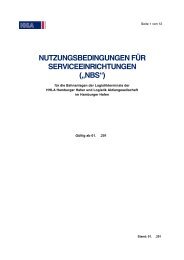
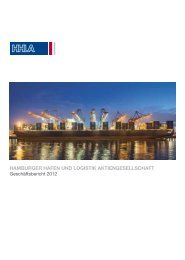
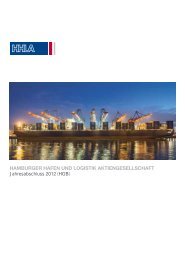

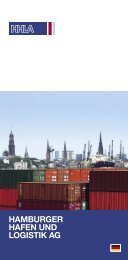
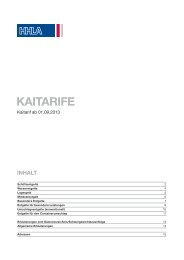
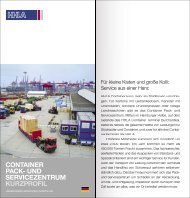


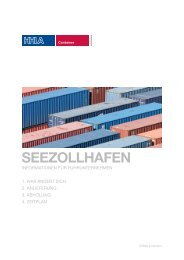
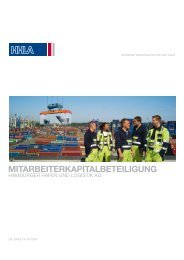
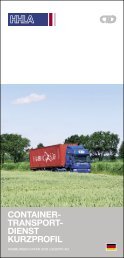
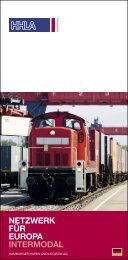
![Presentation [PDF] - HHLA](https://img.yumpu.com/9351898/1/190x135/presentation-pdf-hhla.jpg?quality=85)
